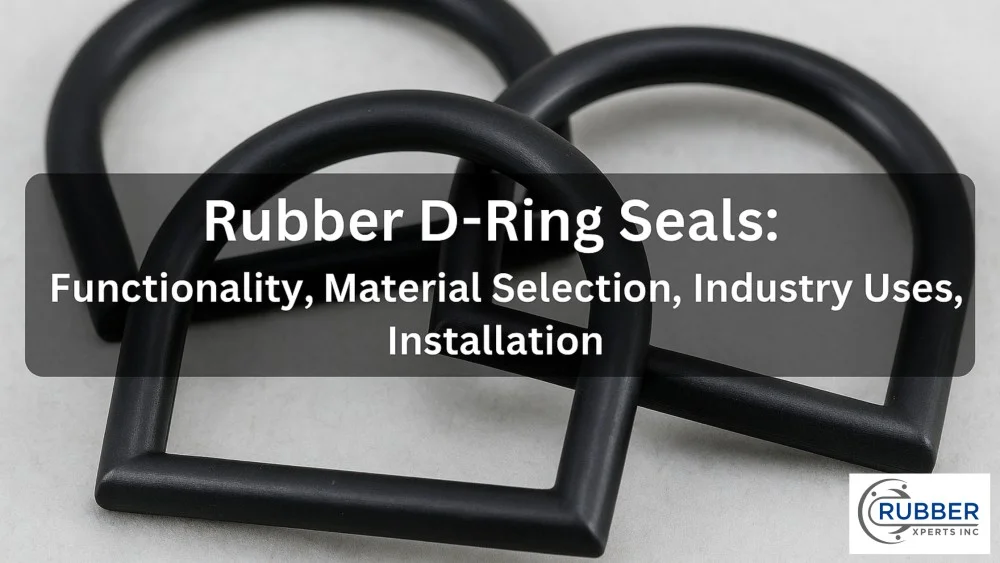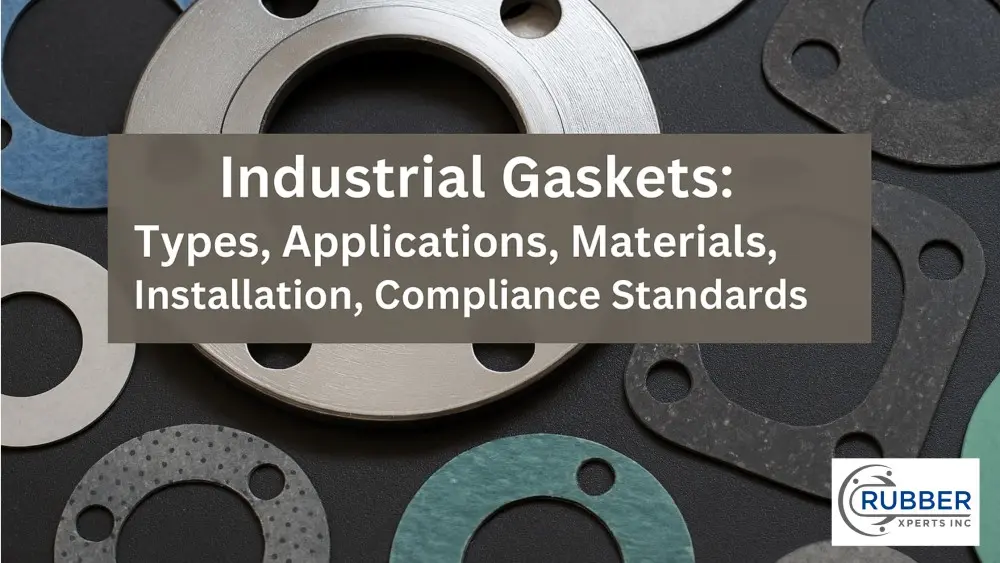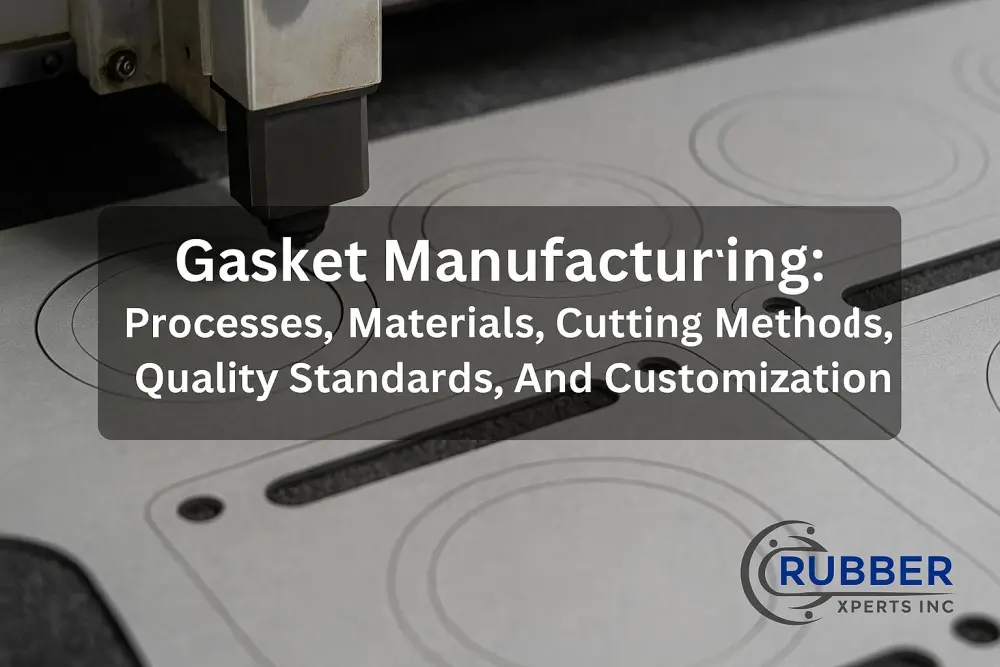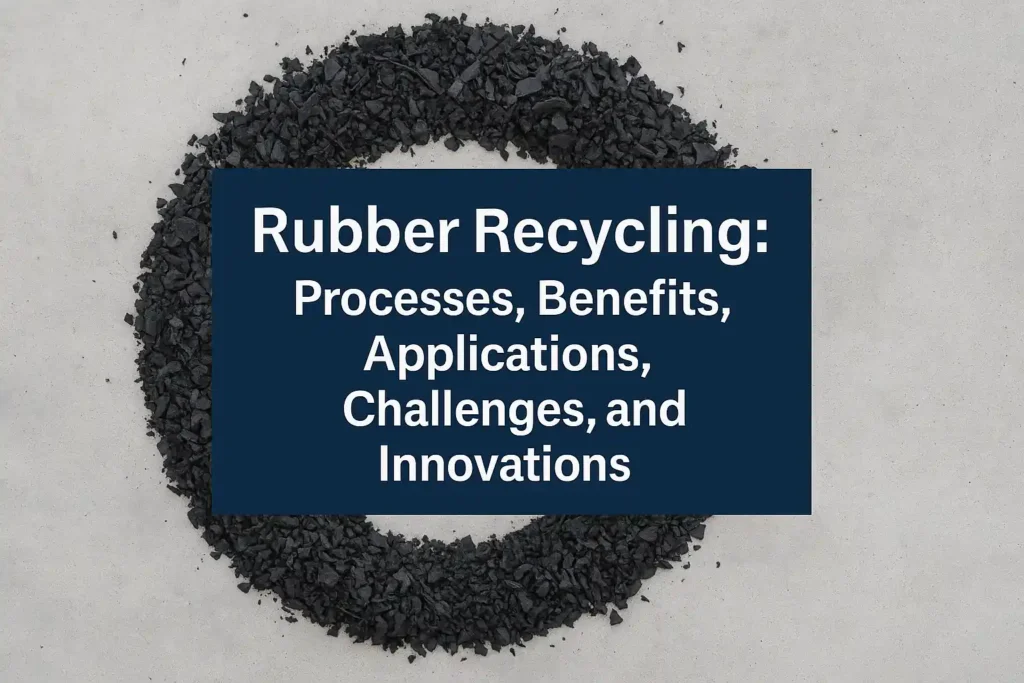Rubber D-ring seals function as custom-fit seals that outperform standard O-rings by resisting twisting, extrusion, and misalignment. By creating tight, stable contact in sealing grooves, they contribute directly to operational safety by preventing leaks and maintaining pressure resistance across thousands of cycles.
The functionalities of rubber D-ring seals include leak prevention, shock absorption, durability, dynamic and rotary application, resistance to wear and stress, and strength. These characteristics ensure consistent sealing efficiency in both static and dynamic conditions.
The available options for material selection of rubber D-ring seals are Nitrile, Fluorocarbon Rubber, Silicone, EPDM, Neoprene, and Butyl. Material selection influences sealing efficiency, durability, and compatibility with fluids, temperatures, and surface conditions.
The industry uses of rubber D-ring seals are aerospace, automotive, marine, chemical and pharmaceutical systems. Each application demands material-specific sealing efficiency and long-term durability under stress, pressure, or motion.
The installation techniques for rubber D-ring seals include press-fit installation, adhesive bonding, compression sealing, stretch-fit installation, and snap-fit installation. Selection of the correct technique ensures stable contact pressure and prevents displacement, wear, or leakage in both static and dynamic assemblies.
Longevity of rubber D-ring seals depends on factors such as wear resistance, aging resistance, chemical resistance, environmental durability, and stress tolerance. These vectors influence how well a seal performs over time in resisting degradation, deformation, or failure.
According to a report by MarketsandMarkets titled “Automotive Gasket & Seal Market by Product Type, Vehicle Type, and Region” 2025, the global gasket and seal market size is projected to reach USD 90.6 billion.
What Are Rubber D-Ring Seals?
Rubber D-ring seals are molded rubber seals with a flat base and a rounded top, forming a D-shaped cross-sectional profile. This geometry creates a more stable contact area in axial and radial applications compared to circular seals.
The primary purpose of a D-ring in industrial sealing is to provide a durable sealing ring that resists rolling, twisting, and extrusion under mechanical load. The flat base anchors the seal during compression, ensuring consistent pressure across the sealing surface.
As an elastomeric ring, the D-profile seal adapts to uneven surfaces while maintaining structural integrity. This makes it suitable for both static and dynamic interfaces where vibration, movement, or pressure changes occur.
The versatile seal design supports applications in custom-fitted grooves and specialized housings. As a customized sealing solution, it addresses failures common in O-rings used under directional stress or repeated motion.
What Are The Functionalities Of Rubber D-Ring Seals?
The functionalities of rubber D-ring seals include leak prevention, shock absorption, durability, dynamic and rotary application, resistance to wear and stress, and strength. Each function addresses a mechanical or environmental demand in sealing systems under pressure or motion.
The functionalities of rubber D-ring seals are as follows:
Leak Prevention
D-ring seals maintain sealing efficiency by forming a stable, leak-proof seal between mating surfaces. The flat base ensures uniform pressure containment while the rounded top conforms to surface irregularities during compression.
This geometry improves fluid retention in both static and dynamic sealing environments. The cross-sectional shape resists rolling, minimizing misalignment and extrusion that cause leaks in traditional seals. D-ring seals function as a gasket alternative where dimensional precision and groove stability are required. Their design enhances sealing performance under vibration, motion, and variable load.
Shock Absorption
D-ring seals provide shock absorption by compressing under mechanical force and redistributing impact energy through the elastomer body. The material’s modulus enables energy dispersion across the contact area without rupture or fracture.
The flat base anchors the seal within the groove, preventing displacement during rapid load changes. This structure supports dimensional stability under pulsation, vibration, or sudden axial movement in dynamic sealing environments. The cross-sectional shape also limits stress concentration. As a result, stress is spread uniformly, reducing material fatigue in the sealing ring and adjacent components over repeated cycles.
Durability
D-ring seals maintain mechanical integrity under repeated compression, friction, and environmental exposure. Their geometry resists shear and tearing inside grooves, improving long-term sealing reliability in both static and moving assemblies.
The elastomeric ring structure withstands deformation and regains its form across pressure cycles. This ensures sealing efficiency without material breakdown in applications involving temperature shifts or load variations. Molded rubber seals with reinforced cross-sections show reduced surface wear and edge cracking. Comparative lab data confirm over 20,000 cycle endurance for high-grade compounds under load-bearing conditions.
Dynamic And Rotary Application
D-ring seals perform in dynamic and rotary systems by maintaining contact under movement without twisting or misalignment. The flat base stabilizes the seal inside the housing while the curved top maintains consistent surface engagement.
The d-profile minimizes drag and reduces frictional heat in rotary shafts and pistons. This supports fluid retention and sealing efficiency in rotational interfaces where speed and directional force vary.
The elastomeric ring adapts to surface motion while preserving pressure containment. This enables use in pumps, valves, actuators, and rotating enclosures without seal fatigue or functional loss.
Resistance To Wear And Stress
D-ring seals resist mechanical wear by distributing load evenly across the sealing interface. The flat base prevents uneven compression while the rounded top maintains consistent sealing under fluctuating forces.
Elastomer blends with abrasion-resistant properties extend the sealing ring’s service life. This reduces surface erosion in contact with metal parts, high-speed shafts, or abrasive media.
The molded rubber seal design prevents edge tearing and material fatigue under stress. This makes it suitable for repetitive loading, frequent motion, and chemically exposed environments requiring sealing retention.
Strength
D-ring seals exhibit high tensile strength and compression stability in demanding sealing environments. The elastomeric ring endures stretching and compressive force without cracking, deformation, or extrusion.
Cross-sectional thickness reinforces the molded rubber seal against shear and groove distortion. This structural strength enables performance in high-load and pressure-concentrated systems. In gasket replacement applications, D-rings retain mechanical shape even after thermal cycling. This ensures pressure containment and sealing efficiency across high-torque assemblies and pressure vessels.
What Options Are Available For The Material Selection Of Rubber D-ring seals?
The available options for material selection of rubber D-ring seals are Nitrile (NBR), Fluorocarbon Rubber (FKM/Viton), Silicone, EPDM (Ethylene Propylene Diene Monomer), Neoprene, and Butyl. Each material offers distinct mechanical, thermal, and chemical resistance properties suited for specific sealing environments.
The available options for the material selection of rubber D-ring seals are explained below:
Nitrile (NBR)
Nitrile rubber is a synthetic elastomer formed by copolymerizing acrylonitrile and butadiene. It is widely used for D-ring seals due to its strong resistance to oils, fuels, and hydrocarbons.
Nitrile rubber’s specialty lies in its balance of abrasion resistance and mechanical durability. It maintains sealing efficiency in environments with oil contact and moderate pressure fluctuations. NBR supports static and dynamic sealing where wear resistance and fluid compatibility are required. This makes it suitable for hydraulic systems, fuel handling equipment, and gasket replacement in industrial enclosures.
In terms of material versatility, NBR offers cost-effective performance with durometer ranges from 40 to 90 Shore A. It supports compression retention without surface degradation across moderate temperatures.
Fluorocarbon Rubber (FKM/Viton)
Fluorocarbon rubber, commercially known as Viton, is a high-performance elastomer derived from vinylidene fluoride-based polymers. It is used in D-ring seals where high thermal and chemical resistance is required.
The specialty of using fluorocarbon materials is their resistance to aggressive solvents, fuels, and high-temperature exposure. FKM maintains sealing efficiency in contact with acids, petroleum-based fluids, and oxidizing agents.
Its low compression set and high tensile strength support long-term sealing in vacuum systems, aerospace components, and chemical reactors. These properties allow pressure containment and dimensional integrity in extreme operating conditions.
As a fluorocarbon material, FKM outperforms standard elastomers in elevated temperatures up to 200°C, while retaining mechanical strength. This makes it necessary for rotary and static seals in chemically reactive environments.
Silicone
Silicone is an elastomer composed of silicon, oxygen, carbon, and hydrogen, known for its flexibility and thermal stability. It is widely used in D-ring seals where clean sealing, non-reactivity, and temperature endurance are required.
The specialty of using silicone elastomer lies in its stability across extreme temperature ranges, from -60°C to 230°C. It maintains sealing efficiency in both freezing and high-heat conditions without hardening or cracking.
Silicone is non-toxic, odorless, and inert, making it suitable for food-grade, medical, and electronic applications. Its low compression set and high elasticity ensure consistent contact under variable pressure.
As a sealing material, silicone elastomer provides material versatility in clean environments where chemical exposure is limited but thermal cycling is frequent. It also resists ozone, UV, and oxidation degradation.
EPDM (Ethylene Propylene Diene Monomer)
EPDM is a synthetic rubber made from ethylene, propylene, and a diene comonomer. It is classified under the group of saturated elastomers and is a preferred material for D-ring seals exposed to outdoor, moisture-rich, or corrosive gas environments.
EPDM options are special because they are resistant to weathering, ozone, steam, and polar fluids. This material maintains sealing efficiency in HVAC systems, potable water fittings, and brake systems.
Its stable structure resists swelling in glycol-based fluids and maintains flexibility in low and high temperature ranges. EPDM performs across -40°C to 150°C without surface cracking or seal deformation. As a material with high abrasion resistance and chemical stability, EPDM supports static sealing in external systems exposed to aging, acid rain, or thermal cycling. It also functions effectively in high-humidity installations.
Neoprene
Neoprene is a chloroprene-based synthetic rubber valued for its balanced resistance to chemicals, weathering, and mechanical stress. It is used in D-ring seals where exposure to oils, moderate chemicals, and outdoor conditions occurs.
Neoprene rubber’s specialty lies in its flame resistance and mechanical stability. It retains sealing efficiency in systems requiring thermal safety and oil tolerance without compromising elasticity. Its moderate hardness range supports reliable compression recovery in HVAC, refrigeration, and industrial panel sealing.
Neoprene also resists tearing and maintains dimensional control under mechanical load. As a material option, neoprene rubber combines abrasion resistance with weather durability, offering versatility across static sealing and gasket replacement. It operates consistently across -30°C to 120°C.
Butyl
Butyl rubber is a synthetic elastomer made from isobutylene with a small amount of isoprene, known for its impermeability to gases and moisture. It is applied in D-ring seals where air and vapor sealing are critical.
Butyl’s specialty lies in its low gas permeability and high resistance to environmental aging. These properties support sealing efficiency in vacuum chambers, gas handling systems, and moisture-sensitive enclosures.
Butyl maintains surface elasticity and dimensional form in nonpolar fluid environments, including air conditioning systems and flexible pipe joints. It also provides acoustic and vibration damping in enclosed spaces. As a sealing compound, butyl offers high abrasion resistance and excellent barrier properties. It performs reliably across -50°C to 120°C with minimal compression set and high resilience under prolonged static load.
What Are The Industry Uses Of Rubber D-Ring Seals?
The industry uses of rubber D-ring seals are aerospace, automotive, marine, chemical and pharmaceutical systems. These sectors require high-performance sealing in environments with mechanical load, chemical exposure, or thermal fluctuation.
The industry uses of rubber D-ring seals are explained below:
Aerospace Industry
The aerospace industry involves the design, development, and operation of aircraft, spacecraft, and related support systems. It requires components that withstand altitude shifts, pressure variation, and extreme thermal conditions. D-ring seals are used in aerospace components such as fuel systems, hydraulic actuators, airframe assemblies, and cabin pressure systems.
These seals support pressure containment and vibration control across static and rotary applications. D-ring seals prevent leakage in aircraft fuel tanks and fluid transfer lines under fluctuating altitude and thermal cycling. Their flat-base geometry stabilizes the seal inside grooves during acceleration and pressurization.
Elastomeric D-ring seals are also used in jet engine housings and electronic enclosures to ensure sealing efficiency in high-vibration zones. Material selection focuses on fluorocarbon and silicone variants for chemical and thermal resistance.
Automotive Industry
The automotive industry covers the manufacturing of vehicles, including engines, transmissions, braking systems, and electronic modules. It demands sealing components that resist oil, fuel, heat, and mechanical vibration.
D-ring seals are used in automotive applications such as fuel injectors, oil pumps, ABS modules, power steering systems, and transmission assemblies. These systems require consistent sealing under pressure and thermal cycling. In engine oil circuits, D-ring seals function as gasket alternatives to maintain fluid retention in confined metal housings.
Their molded profile reduces misalignment during assembly and prevents extrusion during operation. Elastomeric seals are also used in HVAC units and electronic enclosures within vehicles. Nitrile and FKM variants support oil resistance, while EPDM options are applied in coolant and brake fluid systems.
Marine Industry
The marine industry includes shipbuilding, offshore platforms, and equipment used in navigation, propulsion, and fluid handling at sea. Systems operate under corrosive, high-moisture, and pressure-variable environments. D-ring seals are used in marine sealing applications such as bilge pumps, water intake valves, hydraulic winches, and pipe flanges.
These components require leak-proof sealing under constant motion and saltwater exposure. In hull penetrations and propulsion units, D-ring seals prevent water ingress and pressure loss across dynamic shaft interfaces. EPDM and neoprene compounds are selected for their weather resistance and dimensional retention.
Seals are also installed in watertight hatches, ballast systems, and underwater connectors. Their stable groove fit and abrasion resistance protect system reliability in continuous submersion and high-vibration conditions.
Chemical And Pharmaceutical Industry
The chemical and pharmaceutical industry involves the processing, storage, and transport of chemical substances and medical compounds. These environments require strict sealing to prevent contamination, leakage, and chemical degradation.
D-ring seals are used in equipment such as fluid dosing pumps, reactor vessels, valve housings, and pressure filtration systems. These systems require sealing efficiency that is also chemically compatible and hygiene compliant. D-ring seals maintain sterility and pressure containment in pharmaceutical mixers and clean-in-place piping.
Silicone and fluorocarbon materials are used due to their resistance to acids, solvents, and cleaning agents. Seals are also installed in centrifuges, capsule fillers, and transfer lines. Their molded profile supports sealing across stainless-steel grooves and dynamic joints without tearing, swelling, or leaching.
What Are The Installation Techniques For Rubber D-Ring Seals?
The installation techniques for rubber D-ring seals include press-fit installation, adhesive bonding, compression sealing, stretch-fit installation, and snap-fit installation. Each method corresponds to the seal’s geometry, application type, and operating environment.
The installation techniques for rubber D-ring seals are as follows:
Press-Fit Installation
Press-fit installation involves placing the D-ring seal into a machined groove where it holds position through compression and friction. The groove dimensions are designed to match the cross-sectional shape of the D-ring for controlled deformation during assembly.
This method supports sealing efficiency in static joints, flanged housings, and low-motion interfaces. The flat base of the D-ring prevents rotation, while the curved top fills voids to maintain uniform pressure containment.
Common applications include engine block covers, fluid couplings, and hydraulic cylinder end caps. Material choice, such as nitrile or EPDM, ensures abrasion resistance and shape retention under repeated load cycles.
Press-fit installation is preferred where mechanical simplicity and groove tolerance alignment are required. It eliminates the need for adhesives or external fasteners while maintaining a secure sealing interface.
Adhesive Bonding
Adhesive bonding involves securing the D-ring seal into place using industrial-grade bonding agents applied to the groove or mating surface. This technique provides additional retention where vibration, vertical orientation, or surface irregularities are present.
The bonded interface prevents seal displacement during assembly or operation, supporting sealing efficiency under fluctuating pressure and temperature. It is applied in systems where mechanical anchoring alone does not ensure groove stability.
Applications include vertical valve enclosures, panel access covers, and electronic sealing frames in harsh or mobile environments. Silicone and neoprene compounds are commonly bonded due to their compatibility with flexible adhesives.
Adhesive bonding improves seal alignment in pre-assembled units and reduces installation errors. It is used in conjunction with compression or press-fit techniques for dual retention security.
Compression Sealing
Compression sealing relies on axial or radial force applied to the D-ring seal within a confined groove to create a tight sealing interface. The seal is compressed between two mating surfaces, generating uniform contact pressure across the sealing area.
This method is used in static joints where pressure containment and fluid retention are critical. The flat base of the D-ring ensures stability while the rounded top deforms slightly to accommodate surface irregularities.
Compression sealing is used in pump housings, hydraulic manifolds, and access panels in industrial machinery. EPDM, fluorocarbon, and nitrile variants are selected based on fluid compatibility and operating temperature.
Proper groove dimensions and compression force ensure long-term sealing efficiency without extrusion or material fatigue. The method supports high-load sealing in both low-pressure and high-pressure systems.
Stretch-Fit Installation
Stretch-fit installation involves expanding the D-ring seal slightly to fit over a shaft or into a housing before it contracts into position. This method takes advantage of the elastomer’s flexibility and rebound strength to achieve a secure seal.
The technique is used in rotary shafts, cylindrical casings, and slip-on pipe joints where the seal must pass over one or more obstructions. Once in place, the elastomeric ring restores its shape and presses against the mating surfaces.
Materials like silicone elastomer and nitrile rubber are used due to their tear resistance and elasticity. Applications include drive shafts, rotating couplings, and sealed pipe assemblies in both industrial and automotive systems.
Stretch-fit installation supports dynamic sealing in components that require minimal hardware or space. The method depends on accurate sizing and tensile recovery to maintain contact pressure and groove retention.
Snap-Fit Installation
Snap-fit installation uses mechanical features in the housing or groove to lock the D-ring seal into place during assembly. The D-ring is compressed or flexed temporarily, then released to snap securely into a designated retaining channel.
This method prevents axial or radial movement of the seal during operation, even under vibration or pressure changes. It is applied in components where reliable mechanical retention is required without adhesives or fasteners.
Snap-fit designs are used in electronic enclosures, fluid connectors, quick-access panels, and modular equipment housings. Materials with high rebound strength, such as fluorocarbon and EPDM, are preferred to withstand repeated installation and removal.
The technique ensures consistent sealing efficiency across units while simplifying maintenance. It also supports high-volume assembly lines where rapid, tool-free installation reduces production time.
What Is The Longevity Of Rubber D-ring seals?
Longevity of rubber D-ring seals depends on factors such as wear resistance, aging resistance, chemical resistance, environmental durability, and stress tolerance. These factors determine how long a seal maintains sealing efficiency under continuous compression, motion, and chemical exposure.
Seal lifespan is influenced by elastomer type, system pressure, fluid interaction, and installation accuracy. Proper maintenance tips, such as scheduled inspections and replacement intervals, also extend operational life.
The overall average longevity of rubber D-ring seals ranges from 3 to 7 years under normal industrial operating conditions. According to a NASA report titled “Applications Technology Satellite Apogee Rocket Motor-A Summary Report” (1970), high-performance rubber seals in static and dynamic applications demonstrated service life exceeding 25,000 operational cycles under controlled pressure and thermal load conditions.
What Are The Factors Affecting The Longevity Of Rubber D-Ring Seals?
The factors affecting the longevity of rubber D-ring seals are material composition, operating conditions, environmental factors, and installation and maintenance. Seal lifespan decreases when any of these factors fall outside recommended thresholds for the selected elastomer or application type.
The factors affecting the longevity of rubber D-ring seals are explained:
Material Composition
Material composition determines the seal’s resistance to compression, abrasion, and chemical exposure over its service life. Different elastomers respond differently to pressure, temperature, and fluid contact.
For example, EPDM resists water and steam but fails in petroleum oils. Nitrile rubber maintains seal lifespan in oil-rich environments but degrades faster under ozone or UV exposure. Fluorocarbon rubber retains dimensional stability in high-heat chemical systems, while silicone offers thermal flexibility but limited chemical tolerance. These material differences directly impact aging resistance and wear resistance.
Selecting the appropriate elastomer based on application-specific conditions increases environmental durability and ensures consistent sealing performance over time.
Operating Conditions
Operating conditions such as pressure load, temperature range, and motion type directly affect the longevity of D-ring seals. Elevated pressure deforms softer elastomers, while high-speed motion increases surface wear.
For instance, silicone elastomers maintain seal integrity under thermal cycling but compress permanently under continuous high pressure. Nitrile performs well under oil exposure but loses elasticity in cold environments. Dynamic systems with rotary shafts require materials with high rebound strength and abrasion resistance.
Static systems under constant load favor compounds with low compression set, like fluorocarbon rubber. Seal lifespan decreases rapidly when elastomers are exposed to forces beyond their rated mechanical and thermal thresholds. Proper material matching to system conditions maintains sealing efficiency over time.
Environmental Factors
Environmental factors such as UV exposure, ozone concentration, humidity, and chemical contact influence the degradation rate of D-ring seals. These conditions affect the elastomer’s surface integrity and internal structure.
For example, neoprene rubber resists ozone and weathering, making it suitable for outdoor sealing. EPDM performs well in high-humidity environments but swells in oil-based fluids, reducing seal lifespan. In corrosive atmospheres, fluorocarbon materials maintain chemical resistance and surface stability.
Silicone elastomers withstand temperature fluctuations but degrade faster in acidic vapors or oxidizing agents. Environmental durability varies across compounds, and seal failure begins with surface cracking or hardening caused by prolonged ecological exposure.
Installation And Maintenance
Installation and maintenance practices determine seal alignment, surface contact, and long-term retention inside the groove. Incorrect fit, over-stretching, or uneven compression reduces seal lifespan by introducing mechanical stress.
For instance, stretching silicone seals beyond 5% of their inner diameter weakens their rebound strength. Nitrile rings installed into misaligned grooves experience edge shear and premature tearing.
Lack of maintenance causes dirt accumulation and fluid crystallization around the seal, which degrades surface elasticity. Regular inspection prevents seal hardening, swelling, and compression set. Proper groove dimensions, correct technique selection, and scheduled replacement improve stress tolerance and sealing performance over extended cycles.
How To Maximize The Longevity Of D-Ring Seals?
Ways to maximize the longevity of D-ring seals include selecting suitable materials, using correct installation methods, maintaining proper groove dimensions, scheduling routine inspections, and controlling exposure to harmful environments. These actions reduce degradation and support consistent sealing efficiency over the operational lifespan.
Ways to maximize the longevity of D-ring seals are:
- Material Selection Based on Application Needs: Using fluorocarbon materials in chemical handling systems increases seal lifespan by up to three years compared to general-purpose rubber. Nitrile rubber supports oil-based systems with pressure fluctuation while resisting surface softening. Proper matching ensures long-term sealing without premature material fatigue.
- Correct Installation Technique: Compression sealing in machined grooves maintains uniform pressure and prevents extrusion-related failures. For rotary shafts, stretch-fit installations reduce misalignment and improve wear resistance. Choosing the appropriate method stabilizes the D-ring and limits installation-induced defects.
- Maintaining Proper Groove Dimensions: Undersized grooves increase friction and stress on the sealing edge, reducing lifespan in lab tests. D-rings require grooves designed for their cross-section to avoid twisting or overcompression. Dimensional accuracy ensures even force distribution and minimizes material fatigue.
- Routine Seal Inspections and Replacement: Seals exposed to hydraulic oil and vibration should be inspected every six months for cracking or compression. Replacing worn seals before complete failure reduces contamination and system downtime. Scheduled maintenance identifies performance loss before it compromises sealing.
- Minimizing Exposure to Harsh Environments: Installing silicone elastomers in ozone-heavy or high-heat zones without UV shielding reduces lifespan. Environmental protection, such as housing, shielding, or selecting resistant compounds, delays degradation. Controlling contact with oxidizers, fuels, and thermal extremes preserves seal elasticity.
These sealing strategies benefit rubber insulation assemblies, especially where temperature containment and airtight sealing are mission-critical. Applying these methods safeguards both the seal and the system over extended use.
Why Choose Rubber D-Ring Seals?
Choose rubber D-ring seals because they provide stable, leak-proof sealing in systems exposed to pressure, vibration, and misalignment. Their flat-bottom, curved-top geometry maintains groove contact, reduces rolling, and prevents seal displacement during operation.
Rubber D-ring seals ensure sealing efficiency in machinery where traditional O-rings fail under directional or cyclic loading. In hydraulic presses, fuel injection assemblies, and marine propulsion systems, the absence of proper D-ring sealing leads to leakage, mechanical wear, and pressure loss. Their structural profile reduces extrusion risk and maintains fluid retention under repeated compression.
Rubber D-ring seals are important in aerospace valves, chemical tanks, and electronic enclosures. These systems rely on durable elastomeric rings to prevent gas leakage, chemical seepage, and particulate ingress. Without them, temperature shifts and vibration compromise system insulation and critical sealing paths.
What Does D-Ring Stand For?
D-ring stands for a rubber sealing ring with a cross-sectional shape resembling the capital letter “D”. It combines a flat base with a curved top, forming a profile that increases groove stability and sealing contact.
The flat side prevents rotational displacement inside the groove, while the rounded side ensures uniform surface engagement during compression. This design maintains sealing efficiency in both static and dynamic systems under fluctuating loads.
Unlike circular O-rings, D-rings resist twisting, extrusion, and misalignment. These structural advantages make them preferred in aerospace valves, high-pressure fuel circuits, and vibration-prone machinery, where seal failure results in system downtime or fluid loss.
What Is The Difference Between O-Ring And D-Ring Seals?
The difference between O-ring and D-ring seals is in their cross-sectional shape, sealing stability, and performance under directional load. O-rings are circular and symmetrical, while D-rings have a flat base and curved top, offering better groove retention and resistance to twisting.
Below is a table showing key differences between O-ring and D-ring seals:
|
Feature |
O-Ring Seal |
D-Ring Seal |
|---|---|---|
|
Cross-Section Shape |
Circular |
Flat base with curved top (D-shape) |
|
Groove Stability |
Prone to rolling or twisting |
Stable contact under compression |
|
Sealing Efficiency |
Moderate under directional load |
High under axial or radial pressure |
|
Installation Behavior |
Misalign during press-fit |
Anchors are firmly due to a flat base |
|
Dynamic Use |
Lower performance in rotary/moving parts |
Superior performance in dynamic systems |
|
Compression Set |
Varies by material |
Lower set due to balanced geometry |
|
Failure Risk |
Higher in high-vibration conditions |
Lower due to structural alignment |
This structural difference supports the use of D-ring seals in aerospace components, oil systems, and pressurized enclosures, where O-ring performance declines due to twisting or extrusion.
Where To Get Customized Rubber D-Ring Seals?
To get customized rubber D-ring seals, look for industrial seal suppliers specializing in precision-molded elastomer components. These providers offer material selection, durometer specification, and dimensional customization based on application-specific requirements.
Working with a qualified rubber seals manufacturer like us ensures access to high-performance sealing solutions engineered for durability, compatibility, and fit. Manufacturers with in-house tooling and compounding capabilities deliver molded seals for aerospace, automotive, marine, and chemical systems.





